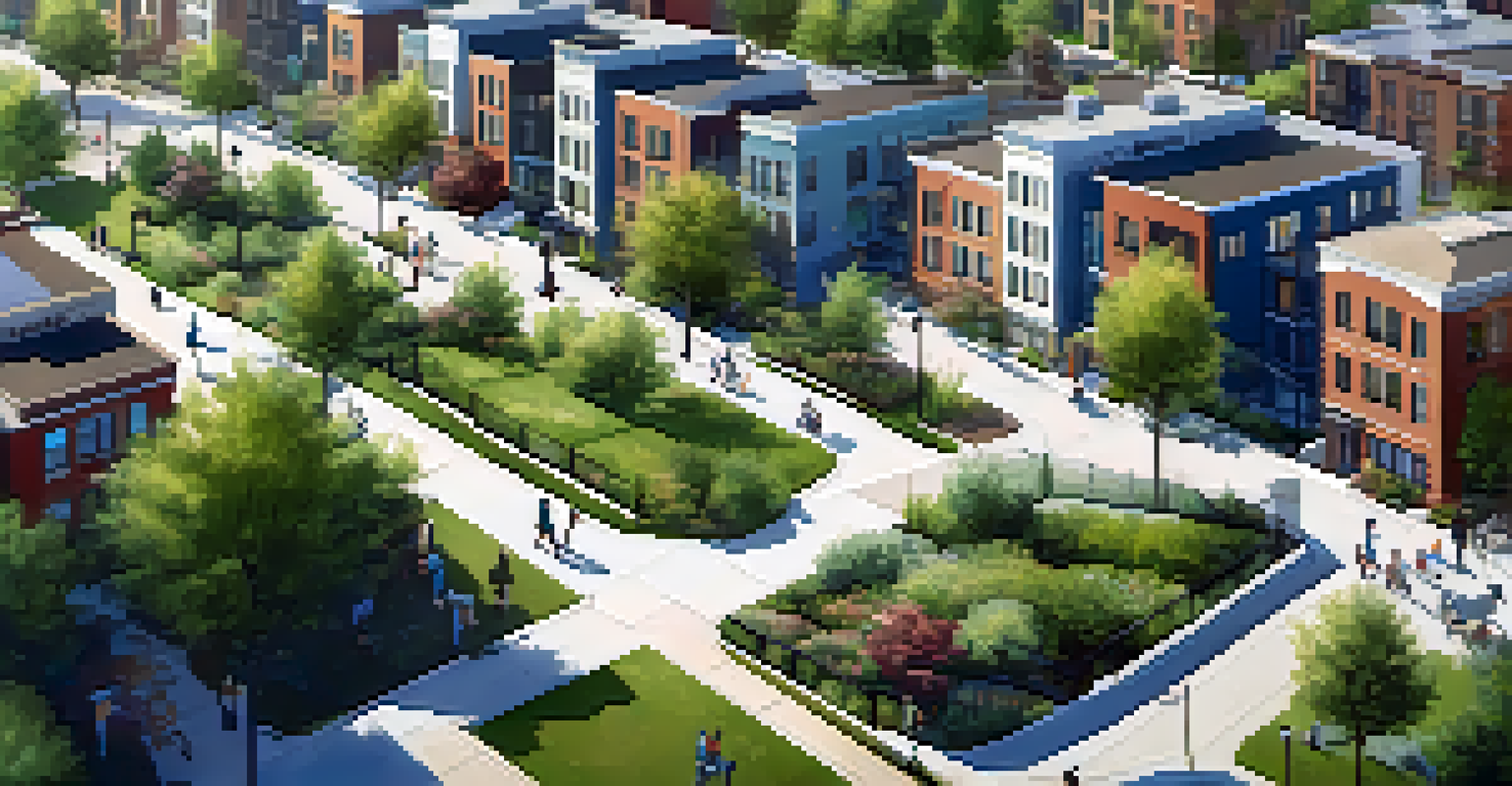Walking and Health: The Benefits of a Walkable Community

Understanding Walkable Communities and Their Importance
A walkable community is designed to encourage walking through accessible sidewalks, pedestrian-friendly streets, and nearby amenities. This type of environment promotes not just mobility but also a healthier lifestyle. Think of it as living in a place where everything you need is just a stroll away, making it easier to choose walking over driving.
Walking is a man's best medicine.
The importance of walkable communities extends beyond convenience; they foster a sense of community. When people walk instead of driving, they are more likely to interact with their neighbors, strengthening social ties. This social interaction can enhance feelings of belonging and safety, making neighborhoods more inviting and enjoyable.
Additionally, walkable areas often see reduced traffic congestion and pollution, contributing to better air quality. As more people choose to walk, the reliance on cars decreases, leading to quieter, cleaner streets. Ultimately, this creates a healthier environment for everyone, making walkable communities a win-win.
Physical Health Benefits of Walking Regularly
Walking is one of the simplest forms of exercise, yet its benefits are profound. Just 30 minutes of brisk walking a day can significantly improve cardiovascular health, strengthen bones, and maintain a healthy weight. It's like giving your body a daily tune-up, keeping it running smoothly.

Moreover, walking can help lower the risk of chronic diseases such as diabetes and hypertension. Imagine your body as a machine; regular walking lubricates the gears, preventing them from rusting and seizing up. This kind of preventative care is crucial for long-term health and vitality.
Benefits of Walkable Communities
Walkable communities promote healthier lifestyles, foster social interactions, and reduce traffic congestion.
In addition to physical health, walking promotes mental well-being. It releases endorphins, those feel-good hormones that boost your mood and reduce stress. So, every step you take not only strengthens your body but also uplifts your spirit.
Mental Health Benefits of a Walkable Community
Living in a walkable community can do wonders for your mental health. Walking outdoors, especially in green spaces, has been shown to reduce anxiety and depression. Picture yourself taking a leisurely stroll in a park; the sights and sounds of nature can lift your mood almost instantly.
To walk in nature is to witness a thousand miracles.
Social interactions that occur when walking in a neighborhood can also combat feelings of loneliness. Whether it’s a quick chat with a neighbor or a wave to a passing friend, these small moments foster connection and community. They remind us that we are not alone, which is vital for our emotional well-being.
Furthermore, walking allows for a break from the hustle and bustle of daily life. It provides a chance to clear your mind and reflect, much like a mini-meditation session. This mental reset can lead to increased productivity and a more positive outlook on life.
Economic Advantages of Walkable Communities
Walkable communities not only benefit health but also have economic advantages. Businesses in walkable areas often see increased foot traffic, leading to higher sales. When people can easily stroll to their favorite café or shop, they are more likely to make spontaneous purchases.
Additionally, property values tend to be higher in walkable neighborhoods. Buyers are increasingly seeking homes in areas where they can walk to work, schools, and parks. This demand can create a vibrant local economy, benefiting everyone from homeowners to business owners.
Health Enhancements from Walking
Regular walking improves physical health, lowers chronic disease risks, and boosts mental well-being.
Moreover, less reliance on cars means lower transportation costs for families. With savings on gas, parking, and maintenance, families can allocate more of their budget to other needs and experiences, enhancing their overall quality of life.
Environmental Impact of Walking and Walkable Communities
The environmental benefits of walkable communities are significant and far-reaching. By promoting walking over driving, we can reduce greenhouse gas emissions, contributing to cleaner air and a healthier planet. Each footstep taken in place of a car ride is a small victory for the environment.
Moreover, walkable areas encourage the development of green spaces and parks, which can improve biodiversity and support wildlife. Imagine a community where trees line the streets, providing shade and habitats for birds and other creatures. These green spaces not only beautify the area but also enhance ecological health.
In essence, creating more walkable communities is a step toward sustainability. It aligns with the broader goals of reducing our carbon footprint and conserving resources, fostering a sense of responsibility towards our planet for future generations.
Designing Walkable Communities: Key Elements
Designing a walkable community requires thoughtful planning and consideration of several key elements. Wide sidewalks, safe crosswalks, and well-placed benches can greatly enhance the walking experience. Think of these features as the building blocks of a pedestrian-friendly environment.
Incorporating mixed-use developments is another important aspect. This means combining residential, commercial, and recreational spaces within walking distance of each other. It’s like creating a mini-city where everything you need is just a short walk away, making life more convenient and enjoyable.
Economic Gains from Walkability
Walkable neighborhoods increase foot traffic for businesses, raise property values, and reduce transportation costs for families.
Lastly, community input is crucial in the planning process. Engaging residents in discussions about their needs and preferences can lead to better outcomes. After all, who knows the community better than the people who live there?
Encouraging Walking: Tips for Residents
Encouraging walking in your community starts with simple lifestyle changes. Try taking short walks during breaks or after meals; it’s a great way to integrate physical activity into your daily routine. Even a 10-minute walk can make a difference in your health and well-being.
Consider walking with a friend or family member to make it more enjoyable. Not only does it provide companionship, but it can also motivate you to stick to your walking routine. Think of it as a social outing that benefits both your health and your relationships.

Lastly, explore your neighborhood and discover new paths and routes. Sometimes the best adventures are just around the corner, waiting to be uncovered. Embracing your local environment can reignite your love for walking and the community you live in.